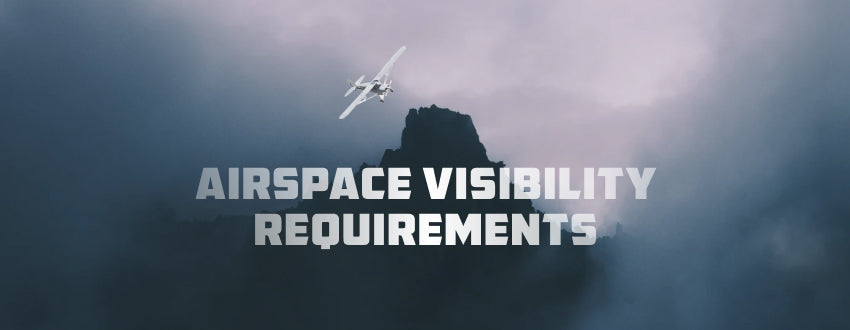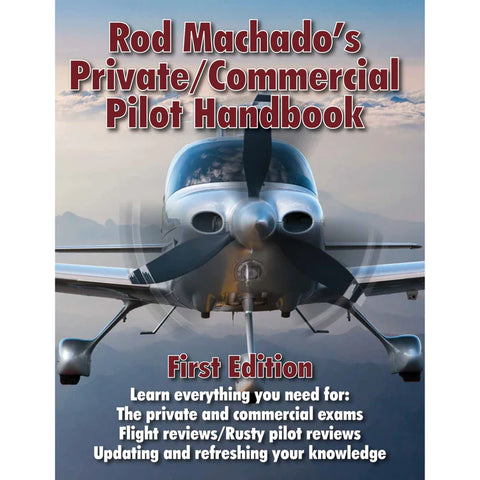Airspace Visibility Requirements: Why are they Mandatory?
The need to see our surroundings is non-negotiable when flying under visual flight rules (VFR). Without proper visibility, pilots are at increased risk for collisions on takeoffs, landings, and mid-air. Therefore we must fly solely in areas with visual meteorological conditions (VMC) and avoid instrument meteorological conditions (IMC) when flying VFR. To promote safe flight, the FAA has established weather minimums and airspace visibility requirements that VFR pilots must observe.

Featured Pilot Gear
Browse our selection of high-quality pilot supplies! Your purchase directly supports our small business and helps us continue sharing valuable aviation content.
The need to see our surroundings is non-negotiable when flying under visual flight rules (VFR). Without proper visibility, pilots are at increased risk for collisions on takeoffs, landings, and mid-air.
Therefore we must fly solely in areas with visual meteorological conditions (VMC) and avoid instrument meteorological conditions (IMC) when flying VFR. To promote safe flight, the FAA has established weather minimums and airspace visibility requirements that VFR pilots must observe.
The weather minimums vary by type of airspace and by altitude, so when planning a VFR flight, it is consider whether the meteorological conditions are expected to meet the minimums of VFR in all the types of airspace and altitudes you will pass through during your flight.
Understanding the purpose of airspace visibility requirements and why airspace visibility requirements are mandatory helps us see and respect their value.
It also guides us in establishing our own personal minimums and in realizing when we may qualify for special clearances that allow us to bend the basic rules.
Table of Contents
 Basic VFR Weather Minimums
Basic VFR Weather Minimums
VFR weather minimums are divided into categories based on type of airspace and flight altitude. For example, VFR flights are generally not allowed in Class A airspace, so VFR visibility requirements do not exist for that class of airspace. On the other hand, Class G airspace has four different sets of corresponding altitude dependent minimums.
For Class B, Class C, Class D, and Class E airspace below an altitude of 10,000’ MSL, the basic VFR weather minimums are:
- Flight visibility of 3 statute miles (SM)
- Cloud clearance of 1,000’ above, 500’ below, and 2,000’ horizontally (except for class B which simply requires pilots to remain clear of the clouds)
Reference the below chart as a guide to understanding the basic VFR weather minimums at each altitude and for each type of airspace:
|
Type of Airspace |
Altitude |
Flight Visibility |
Cloud Clearance |
|
Class A Airspace |
N/A – No VFR flight allowed |
N/A – No VFR flight allowed |
N/A – No VFR flight allowed |
|
Class B Airspace |
Below 10,000 MSL |
3 SM |
Clear of clouds |
|
Class C Airspace |
Below 10,000 MSL |
3 SM |
1,000’ above; 500’ below; 2,000 feet horizontally |
|
Class D Airspace |
Below 10,000 MSL |
3 SM |
1,000’ above; 500’ below; 2,000’ horizontal |
|
Class E Airspace |
Above 10,000 MSL |
5 SM |
1,000’ above; 1,000’ below; 1 SM horizontal |
|
Class E Airspace |
Below 10,000 MSL |
3 SM |
1,000’ above; 500’ below; 2,000 feet horizontally |
|
Class G Airspace |
Below 1,200 AGL (Day) |
1 SM |
Clear of clouds |
|
Class G Airspace |
1,200 AGL – 10,000 MSL (Day) |
1 SM |
1,000 feet above; 500’ below; 2,000 feet horizontal |
|
Class G Airspace |
1,200 AGL – 10,000 MSL (Night) |
3 SM |
1,000 feet above; 500’ below; 2,000 feet horizontal |
|
Class G Airspace |
Above 10,000 MSL |
5 SM |
1,000’ above; 1,000 feet below; 1 SM horizontal |
Special VFR Weather Minimums
Sometimes conditions are just barely at or above those for basic VFR minimums. This is referred to as marginal VFR or MVFR. Marginal VFR conditions are characterized by ceilings of 1,000 – 3,000’ and a visibility of 3 - 5 statute miles.
Since these conditions are right on the border of not qualifying as VFR, pilots should exercise caution and consider their alternatives.
If conditions continue to deteriorate until they are below basic VFR minimums at or around an airport that has controlled airspace down to surface level, VFR pilots may still be able to get approval for takeoff or landing.
Pilots may request a Special VFR (SVFR) clearance from Air Traffic Control. The controller has the discretion to issue a special VFR clearance provided the pilot and aircraft meet certain requirements and that the SVFR traffic would not interfere with existing IFR traffic in the area.
In addition, the following special VFR weather minimums apply:
- Ability to remain clear of the clouds
- At least 1 statute mile of ground visibility
Why are airspace visibility requirements mandatory?
VFR airspace visibility requirements are designed to help pilots flying under visual flight rules see and avoid each other as well as to create separation between VFR and IFR aircraft.
The flight visibility and cloud clearance requirements increase with altitude because aircraft at those altitudes will typically be moving at higher velocities.
These faster moving aircraft need more time and distance to see and avoid other aircraft. Lower, slower moving aircraft can react safely with less flight visibility and reduced cloud clearance.
Controlled Airspace
"What is controlled airspace?"
This refers to controlled airspace designated with specific dimensions where air traffic control services are offered to both Visual Flight Rules and Instrument Flight Rules flights.
This term encompasses various classifications of airspace, such as Class A, B, C, D, and E, each with its own defined dimensions and provisions for air traffic control services for IFR and VFR flights.
Uncontrolled Airspace
"What is uncontrolled airspace?"
Class G airspace, also known as uncontrolled airspace, refers to areas of airspace that have not been designated as Class A, B, C, D, or E. To ensure the safety of their flight, pilots must follow specific visual flight rules (VFR) to help them see and avoid other aircraft within this type of airspace.
Special Use Airspace
'What is special use airspace?"
Imagine a designated area, outlined on a map as a specific shape, where certain activities must be contained due to their inherent nature or where restrictions are placed on aircraft operations that do not pertain to those activities. In other words, it's like a designated no-fly zone for safety and operational purposes.

-
What is the minimum visibility in controlled airspace?
In Class C airspace and Class D airspace, a helpful way to remember VFR minimums is to think of "3 Cessna 152's". A flight visibility of 3 statute miles, and a minimum cloud clearance of 1,000 feet above, 500 feet below, and 2,000 feet horizontal.
-
What is VFR visibility range?
In Class B, C, D, and Class E airspace under 10,000 MSL the flight visibility requirement is 3 statute miles.
-
What are VFR visibility and ceiling requirements?
This is different depending on the class of airspace you are flying in. In Class C, D, and E if you are under 10,000MSL then you need to have a visibility of 3 statute miles and distances from clouds of 1,000 feet above, 500 feet below, and 2,000 feet horizontal.
In Class B airspace you need to simply remain clear of clouds.
-
What are the cloud clearance requirements above 10,000 ft?
Above 10,000 flight visibility changes, you will need a visibility of 5 SM and the cloud clearance requirements are 1,000 feet below, 1,000 feet above, and 1 statute mile horizontal.
Takeaways
Pilots who are flying under visual flight rules must ensure that they are flying within the FAA’s airspace visibility requirements for the type of airspace they are occupying at any given time.
Basic airspace visibility requirements provide a standard safety margin that the FAA has deemed appropriate in most situations, however the FAA also allows latitude for a pilot to request a special VFR clearance if circumstances and pilot training/skill level warrant it.
In addition to the FAA’s official weather minimums, seasoned pilots commit to their own personal minimums. These minimums may be more restrictive than the legal minimums and are especially important for pilots who are rated solely for VFR flying since if conditions deteriorate, a VFR-only pilot does not have the option to switch to IFR.
Respecting VFR minimums and flying within them helps keep not only the VFR pilot but also local IFR traffic properly spaced and safe.
Have more airspace or cloud class related questions?
-
Class A Airspace and How it Differs from All Other Categories of Airspace
- Cloud Ceilings: What Pilots Should Know (Complete Guide)
Did you find this article helpful?
Do you think we missed anything important? Let us know in the comments below!































